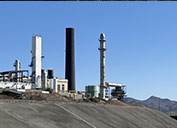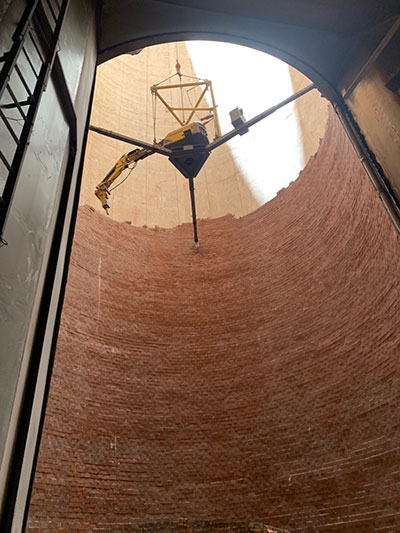Historic Black Smokestack at Miami Smelter to Come Down After More Than a Century

 November 9, 2023 - The iconic black smokestack that has towered over the Miami, Ariz., smelter for more than 100 years is being taken down to make room for modern cooling equipment needed to sustain the operation.
November 9, 2023 - The iconic black smokestack that has towered over the Miami, Ariz., smelter for more than 100 years is being taken down to make room for modern cooling equipment needed to sustain the operation.
The smokestack was built in 1914 to vent gases from the smelter. It has been out of service for two decades as modern scrubbing equipment was installed in the early 2000s in response to changing environmental regulations. Once demolition is complete, the site will become the location for auxiliary cooling equipment needed for a new state-of-the-art electric furnace that will be installed at the smelter in 2024.
“It has sentimental value for all of us in the plant and the community,” said Mark Albertsen, General Manager-Miami. “By removing the stack, it provides the necessary area to continue our modernization and sustainability efforts at the Miami smelter. We are committed to responsible operation and safe production at Miami operations and intend to be here for generations to come.”
The smokestack was built by the International Smelting Company when it began producing copper at the then-new smelter in Miami. Freeport-McMoRan acquired the smelter with the Miami operations in its purchase of Phelps Dodge Corp. in 2007. The structure is 244 feet tall, made of brick and tile and was partially plated with steel. Its diameter at the base is 37 feet, and it narrows to 26 feet at the top. The Miami facility is one of only two copper smelters still operated in the United States.
Up to the challenge
Bringing down the smokestack safely poses some challenges, said Derek Reed, Manager-Project Controls.
“One of the concerns that we have is that where this black stack sits is in the middle of an operating plant,” Reed said. “So, you can’t take it down by means and methods like we’ve done on other copper smelter stacks where we actually implode it and have it fall over like a tree.”
Rather than having people with jackhammers chipping away the bricks, a machine called a cricket will be used. A cricket is basically a platform that will be placed inside the smokestack and suspended with a crane. It supports a remote-controlled device called a Brokk machine that can reach outside the stack and demolish the material so it falls safely inside. The rubble can then be cleaned out periodically and safely from the bottom. An operator will be on the exterior scaffolding to control the machine remotely from a safe distance away, along with a couple of workers who will be there to clear away any debris.
“It takes people out of the line of fire,” Reed said. “It’s the safest way to do it with minimal impact to operations.”
The cricket should be able to chip away about 14 feet per day. Once the stack is down to about 30 or 40 feet, crews will switch to conventional excavating equipment to finish the job.
Work began on October 30 and is expected to take four to six weeks to complete.

Photos (top right; bottom left to right): : A machine called a cricket will be used to bring down the smokestack safely; Work on the black smokestack at the Miami smelter began in 1914; The iconic black smokestack that has towered over the Miami smelter for more than a century is being taken down to make room for modernization efforts.



 BACK
BACK
SOCIAL
RECOGNITION